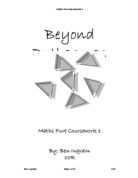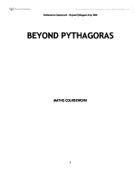By putting the triplets I am provided with in a table, along with the next four sets, I can search for formulae or patterns connecting the three numbers.
Investigation:
Patterns in ‘a’: The smallest numbers always increase by 2 in this family.
Relations between ‘n’ and ‘a’: The only pattern that I can see in these two sets of numbers is that ‘a’ is always double ‘n’ plus 1. E.g. 1 and 3
1 x 2= 2
2 + 1= 3
This works with all of the above pairs. It can be expressed algebraically as: 2n + 1=a
Patterns in ‘b’: The numbers in the ‘b’ column increase uniformly in a pattern that in itself increases by 4 every time.
8 12 16 20 24 28
4 4 4 4 4
This however cannot be used to form a formula as it could not be worked out for the nth term.
Relations between ‘a’ and ‘b’: The relationship here is that multiplying ‘a’ by ‘n’ then adding ‘n’ always leaves you with ‘b’. E.g. 1 and 5
5 x 1= 5
5 + 1= 6
This works for each one and can be expressed as the formulae: an + a= b
Relations between ‘b’ and ‘c’: The obvious relation here is that ‘c’ is always one more than ‘b’. E.g. 5 is one more than 4
13 is one more than 12
and so on…
Expressed algebraically this is: b + 1= c
However, these formulae only work if you do them in order. I.e. find ‘a’ then ‘b’ then ‘c’.
I need formulae that will find the nth term for any of the numbers, whether it be the sides, area or perimeter.
The previous formula for ‘a’ can be used as this only uses n: 2n + 1=a
Formula for ‘b’: As the difference between the numbers is different and the second difference is always the same the formula must use n2. It also uses the 2n as that was the difference in the first column. The formula is: 2n2 + 2n= b. E.g. (2 x 3) 2 = 18
2 x 3 = 6
18 + 6 = 24
Formula for ‘c’: As already identified above, ‘c’ is always one more than ‘b’, therefore the same formula can be used and then add one: 2n2 + 2n + 1= c. E.g. (2 x 3) 2 = 18
2 x 3 = 6
18 + 6 = 24
24 + 1= 25
Formula for perimeter: The perimeter of a triangle is the total of all three sides, therefore you simply add all the prior formulae together. When simplified it equals: 4n2 + 6n + 2. E.g. (4 x 1) 2 + (6 x 1) + 2
4 + 6 + 2 = 12
3 + 4 + 5 = 12
Formula for area: The area of a triangle is ‘(a x b)/2’. Therefore the formulae is the same as the ones above, then divided by two: 2n³ + 3n² + n. E.g. (2 x 2)³ + (3 x 2)² + 2
16 + 12 + 2 = 30
½ x 5 x 12 + 30
However, there are some sets that adhere to the rules of Pythagoras, but not those above. Triplets such as 9,12,15 and 6,8,10 can be achieved but only with halves. Therefore it does not conform to my aim.
Because of these exceptions, my results cannot be said to be fully complete. Only with a formula that includes these exceptions could it be thought totally complete.
To prove my formulae are the same as those of Pythagoras I must put it into the form of: a²+b²= c². Simplify it and see if it cancels out.
8n³ + 4n² + 1on + 4n + 1 8n³ + 4n² + 1on + 4n + 1
As shown, once factorised and multiplied out the brackets, all the values cancel out. This means that my formulae are correct and adhere to the rules of Pythagoras.
Part 2:
Aim: To investigate other families of triplets and their formulae.
Investigation 1: The investigation is going to be into the multiples of the triplets used in the primary tests.
I believe that each of the triplets in the above table will adhere to the rule of Pythagoras. To prove my theory I will randomly select some triplets and test them:
The fact that the two smaller numbers (when squared) add up to the same as the third number (when squared), proves my theory that multiples of Pythagorean triplets will also adhere to the rules of Pythagoras. My formulae can be changed to suit this:
y (2n + 1 = a)
y (2n2 + 2n = b)
y (2n2 + 2n + 1 = c)
y (4n2 + 6n + 2 = perimeter)
y (2n³ + 3n² + n = area)
In all the above cases, ‘y’ is a substitute for any number, when replaced it can be worked the same as the normal formula, multiplied and still produce a Pythagorean triplet.
E.g. 3 x ((2 x 4) + 1) = 27
3 x ((2 x 4)² + 8) = 120
120 + 3 = 123
Once again the triplets from this family can be put into a table showing not only themselves, but also the fact that they conform with the rules of Pythagoras. In this case it is the multiples of my primary triplet; 3,4,5.
As you can see, when squared, the first two columns add up to the third number squared. This proves that my hypothesis is correct and multiples of triplets do conform with the rules of Pythagoras. This is true with both odd and even numbers being inserted into the ‘a’ column.






